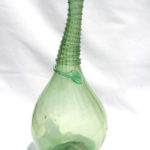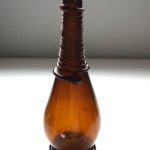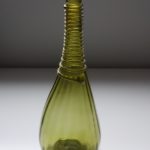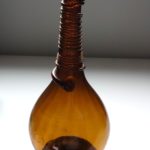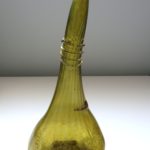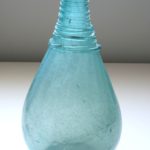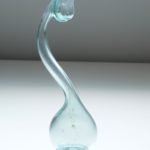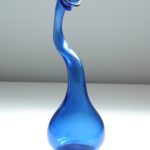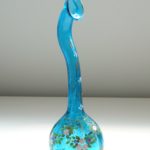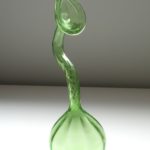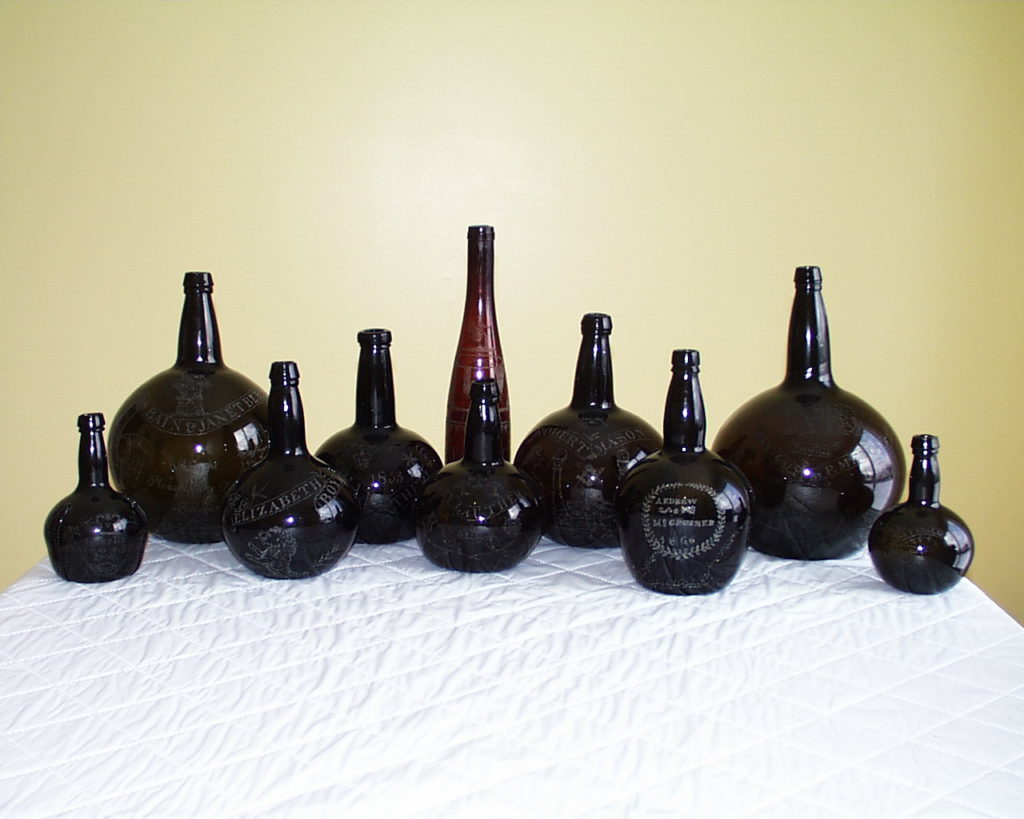 SCOTTISH STIPPLES – DATED EXAMPLES:
SCOTTISH STIPPLES – DATED EXAMPLES:
This method of engraving bottles is associated with the Alloa glasshouse.
1834
“WILLIAM DRYSDALE’ on a banner with foliage “Born Nov /4th / 1834” (engraved)
Alloa glass Bulbous Cylinder, unsealed, dark green glass, ‘chip’ engraved.
Provenance – The bottle is thought to belong to William Drysdale who was christened 28th June 1835 in Alloa, Clackmannanshire, Scotland. William was the son of Laurence Drysdale and Helen Maule who were married 27th March 1830 in Alva, Stirling, Scotland.
1835
“MARY LAUTHER / 1835” (engraved)
Alloa glass Bulbous Cylinder, unsealed, dark green glass, ‘chip’ engraved.
Provenance – Almost certainly of Scottish origin and probably originates from the Alloa Glassworks.
“JOHN & BARBARA ROXBURGH / 1835’ (engraved)
Alloa glass Bulbous Cylinder, unsealed, dark green glass, ‘chip’ engraved.
Provenance – Almost certainly of Scottish origin and probably originates from the Alloa Glassworks.
1836
“THOMAS BAIN & JANET BERRIE” within a banner /”‘1836 Plough is the Dairy
/ Present” (engraved)
Alloa glass Bulbous Cylinder, unsealed, dark green glass, ‘chip’ engraved.
Provenance – Almost certainly of Scottish origin and probably originates from the Alloa Glassworks. A Thomas Bain married Janet Berrie on the 26th June 1835 in Denny, Stirling, Scotland.
“GEORGE & ELIZABETH BOYACK” (in scrollwork) / “1836 / a lion” (engraved) Scotland Name
Alloa glass Bulbous Cylinder: Ht 216mm., diameter: 146mm., olive-green glass, tapered double collar lip, with open glass pontil, small ‘kick-up’ to base, ‘chip’ engraved.
Provenance – Almost certainly can be attributed to the Alloa Glassworks, Alloa, Clackmannanshire, Scotland. George Boyack married Elizabeth Kirk on 24th April 1825 in St Cuthbert’s, Edinburgh, Scotland. It appears that George and Elizabeth moved to St Andrews or the nearby St Leonards, Fifeshire, Scotland shortly after the marriage. The bottle may celebrate the birth of their second son, James Duncan Boyack, in 1836. Records show that the couple had two other sons, John Carnegie Boyack born 4th October 1829 and George Hutton Boyack born 29th April 1838.
1837
“Chas. Jackson / Nov 14th 1837” (engraved)
Cylinder, unsealed: Ht 226mm., ‘chip’ engraved.
Provenance – An unusual dated engraving of an unsealed bottle that gives the appearance of being foreign, possibly French, but with an English name. There is a possibility that this may be another example of Scottish stippled glass engraving.
“ROBERT MASON / 1837” with Masonic Symbols, on the reverse is the image of a man at a lectern with gavel and paper (engraved)
Alloa glass Bulbous Cylinder, unsealed: Ht 254mm., diameter: 178mm., olive-green glass, tooled double collar lip and open pontil, ‘chip’ engraved.
Provenance – Probably from the Alloa Glassworks, Scotland and thought to be a freemasons bottle, perhaps commemorating the date of entry to the lodge or the election of Robert Mason as Worshipful Master. A Robert Mason is recorded as marrying Elizabeth Bald on the 12th December 1835 in Alloa, Clackmannan, Scotland. Another Robert Mason was born 4th July 1789, in Alloa, Clackmannan, Scotland who would have been 48 years of age at the date commemorated on the bottle. Another possibility would be Robert Mason who was christened 13th June 1785, also in Alloa, Clackmannan, Scotland, the son of James Mason and Margaret Mitchell, who would have been 52 when this bottle was engraved. Canadian Private collection.
“HELEN METCALF (from P METCALF) / 1837” (engraved)
Alloa glass Cylinder, unsealed, ‘chip’ engraved.
Provenance – Probably attributed to the Alloa Glassworks and almost certainly of Scottish origin. (See similar engraved bottle dated 1839).
“Isabella Young 1837” (engraved)
Alloa glass Cylinder, unsealed: Ht 240mm., diameter: 135mm., dark green glass,
‘chip’ engraved.
Provenance – The engraving originates from the Alloa Glassworks, Alloa, Clackmannanshire, Scotland where ‘chip’ engravings where made by the use of a sharp hammer on cylinder-shaped bottle glass. This method of engraving bottles is associated with the Alloa glasshouse. National Museum of Scotland, History and Applied Art collection, Accession No. H.NDB SMITH 3882.
1838
“WILLIAM KEMP 1838” within a banner, surmounted by wheat sheaves, and above an array of Masonic Symbols and tools (engraved)
Alloa glass Bulbous Cylinder, unsealed: Ht 240mm., dark green glass, ‘chip’ engraved.
Provenance – Probably manufactured at the Alloa Glassworks, Scotland. Reference: British Glass 1800-1914 by C. R. Hajdamach 1993, page 186, Plate 124.
1839
“Presented to HELEN METCALF By P. METCALF as a MARK of respect 1839” with images of thistles, roses, a cow being milked, and on the reverse a large cornucopia with “Plenum Cornu” (engraved)
Alloa glass Bulbous Cylinder, unsealed: Ht 320mm., diameter: 210mm., dark olive-green glass, tooled double collar, open pontil, ‘chip’ engraved.
Provenance – Probably from the Alloa Glassworks and of Scottish provenance. (See similar engraved bottle dated 1837). Nightingale Private sale 1999, £650. Canadian Private collection. 1837 or 1839.
1840
A scene including the motto “ SPEED THE PLOUGH” on the obverse is the arms of the Earl of Stirling, with engraved by D. Erskine Alloa 1840. around the base.
Bulbous “Alloa Chip” type: Ht 305mm., deep-green glass.
Provenance – Probably from the Alloa Glassworks. Chip engravings where made by a sharp hammer on bottle glass associated especially with the Alloa glasshouse. Reference: Nineteenth Century British Glass, H. Wakefield, 1961 / 1982 pages 85/86, Figure 82, (pp168). Stirling Art Gallery and Museum collection.
1842
ISABELLA BOW 1842 (engraved)
Alloa glass Cylinder, unsealed, ‘chip’ engraved.
Provenance – Attributed to the Alloa, Glassworks, Scotland and probably of Scottish origin.
1845
ROBERT FALCONER 1845 (engraved)
Alloa glass Cylinder, unsealed, ‘chip’ engraved.
Provenance – Attributed to the Alloa, Glassworks, Scotland and probably of Scottish origin.
1847
JANET STEVENSON / Grumble St / 1847 with Heart / Arrow and Crown decorations
“Alloa Chip” type:
Provenance – Attributed to the Alloa Glassworks, Scotland and of Scottish origin. Edinburgh Museum collection.
1848
WILLIAM AND MARY CARSE 1848 (engraved)
Alloa glass Cylinder, unsealed, ‘chip’ engraved.
Provenance – Attributed to the Alloa Glassworks, Scotland and probably of Scottish origin.
Isabilla Dickie made by Alloa Glassworks 1848, with Beehive and House (engraved)
Alloa glass Bulbous Cylinder, unsealed: Ht 305mm., dark green glass, ‘chip’ engraved.
Provenance – Probably from the Alloa Glassworks and of Scottish provenance. ‘Chip’ engravings were made by a sharp hammer on cylinder-shaped bottle glass and are associated primarily with the Alloa glasshouse. National Museum of Scotland, History and Applied Art collection, Accession No. H.1994.1109.
1848 engraved by D. Eskine.
Alloa glass Cylinder, unsealed, ‘chip’ engraved.
Provenance – Attributed to the Alloa Glassworks, Scotland and probably of Scottish origin. (See 1840 for the same engraver).
1849
Scotland Name1849
Agnes Struthers made by Alloa Glassworks 1849 (engraved).
Alloa glass Bulbous Onion/Cylinder, unsealed: Ht 140mm., diameter: 210mm., dark green glass, ‘chip’ engraved.
Provenance – Scottish made by the Alloa Glassworks, Clackmannanshire. National Museum of Scotland History and Applied Art collection Accession No H.1994.1110.
1851
Robt & Barbara Gillespie 1851 (engraved).
Alloa glass Cylinder, unsealed: Ht 205mm., diameter: 111mm., dark green glass, ‘chip’ engraved.
Provenance – Attributed to the Alloa Glassworks, Clackmannan, Scotland, Alloa chip. National Museum of Scotland History and Applied Art collection Accession No NDB SMITH 2179.
Elizabeth Jamieson 1851(with City of Glasgow Coat-of-Arms (engraved)
Alloa glass Bulbous Cylinder, unsealed, ‘chip’ engraved.
Provenance – Attributed to the Alloa Glassworks, Clackmannan, Scotland. The bottle is from Glasgow, having the Glasgow Coat-of-arms. Such bottles appear to be manufactured to celebrate births, marriages, anniversaries, and other special occasions. Such engraving have farm scene, ships, birds, and of course, rose-and-thistles galore.
John Lennox of Carbridge, made by Alloa Glassworks 1851(engraved).
Alloa glass Onion Cylinder, unsealed, dark green glass, ‘chip’ engraved.
Provenance – Probably from the Alloa Glassworks and of Scottish provenance. National Museum of Scotland, History and Applied Art collection, Accession No. H.1994.1111.
1853
JOHN ERSKINE 1853
“Alloa Chip” type Alloa glass Cylinder, unsealed, ‘chip’ engraved.
Provenance – Probably attributed to the Alloa Glassworks, Clackmannan, Scotland.
HUTCHISON 1853
Alloa glass Cylinder, unsealed, ‘chip’ engraved.
Provenance – Probably attributed to the Alloa Glassworks, Clackmannan, Scotland.
JEAN SUTHERLAND enclosed within a decorated heart, 1853, Crown and Star inside heart, together with Rose and Thistle, Three Storey House and Two Trees (engraved).
Alloa glass Bulbous Cylinder, unsealed, olive-amber glass, straight collar, a lightly polished glass ring pontil, ‘chip’ engraved.
Provenance – Probably attributed to the Alloa Glassworks, Clackmannan, Scotland. The house depicted on the bottle, obviously has some significance to Jean Sutherland, perhaps where she resided or was born. Canadian Private collection
1854
Initials with a Heart and New Year Greeting made by Alloa Glassworks, 1861 (engraved)
Mallet “Alloa Chip”: Green glass, deep kick-in, stippled.
Provenance – Scottish. National Museum of Scotland History and Applied Art collection Accession No H.1994.1112.
1861
“Initials” (no details) with a “heart” and “New Year Greeting made by Alloa Scotland Initials Glassworks, 1861” (engraved)
Alloa glass Mallet, unsealed, dark green glass, deep ‘kick-up’ to base, ‘chip’ engraved.
Provenance – Probably from the Alloa Glassworks and of Scottish provenance. National Museum of Scotland, History and Applied Art collection, Accession N. H.1994.1112.
1866
“ANDREW / decoration / McGRUTHER / 1866” within a reef, on the reverse, a bottle, glass and tumbler (engraved).
Alloa glass Bulbous Cylinder, unsealed: Ht 248mm., diameter: 146mm., olive-green glass, tooled double collar lip, free blown, bulbous-shaped neck, open glass pontil, ‘chip’ engraved.
Provenance – Almost certainly of Scottish origin and possibly attributed to Andrew McGruther who was christened 12th April 1840 in Blackford, Perth, Scotland, the son of William McGruther and Mary Ailace. He would have been 26 years of age at the date commemorated on the bottle. Canadian Private collection.
1869
“William Comrie with Birds and a Hunting Dog
made by Alloa Glassworks 1869” (engraved).
Alloa glass Cylinder, unsealed, dark green glass, ‘chip’ engraved.
Provenance – Probably attributed to the Alloa Glassworks, Clackmannan, Scotland. National Museum of Scotland History and Applied Art collection Accession No H.1994.1113.
“THOMAS and ELIZABETH JENAT 1869” (engraved).
Alloa glass Cylinder, unsealed and ‘chip’ engraved.
Provenance – Probably attributed to the Alloa Glassworks, Clackmannan, Scotland.
1871
“Cicila of Bathgate” with “ Burns Monument made by Alloa Glassworks 1871” (engraved).
Alloa glass ‘hock’ style Cylinder, unsealed, brown glass, ‘chip’ engraved.
Provenance – Scottish. National Museum of Scotland History and Applied Art collection Accession No H.1994.1114.
1874
“Bell A Dron 1874” (engraved)
Alloa glass Cylinder, unsealed: Ht 240mm., diameter: 120mm., dark green glass, the bottle shape not symmetrical, ‘chip’ engraved.
Provenance – Attributed to the Alloa Glassworks, Clackmannan, Scotland. National Museum of Scotland History and Applied Art collection Accession No NDB SMITH 2178.
1875
“Hellen Carmichael 1875” with a Bird, Sailing Vessel, plant (engraved)
Alloa glass Cylinder, unsealed: Ht 178mm., deep olive-green glass, stippled, with smooth base, ‘chip’ engraved.
Provenance – Probably attributed to the Alloa Glassworks, Clackmannan, Scotland. An example sold at a Glass Works Auction, 12th March 2001, estimate US$375-475.
1877
“BURDON 1877” engraved
Alloa glass Cylinder, unsealed, ‘chip’ engraved.
Provenance – Probably attributed to the Alloa Glassworks, Clackmannan, Scotland.
1878
“Mr & Mrs Watt 1878” (engraved)
Alloa glass Cylinder, unsealed, ‘chip’ engraved.
Provenance – Probably attributed to the Alloa Glassworks, Clackmannan, Scotland.
A gift from Sunderland (engraved)
“Alloa Chip” type:
Provenance – Probably attributed to of the North East Glasshouses given the inscription.
1888
“IN / LOVING MEMORY / OF / WILLIAM ELEXANDREW /ANDE…..RSON / Scotland Name
WHO DIED / AUG 17TH 1888 AGE 22”
Witch’s Ball or fishing float, black glass, smoothly spherical, with only the corked blowhole interrupting the surface. this bottle serves as a tribute to the passing of a resident of New Pitsligo, Aberdeen. The engraving is generally in serif caps of varying sizes, mostly horizontal. The date line, in semi-circular styling, is towards the base, contained within an overall oval laurel border with flower heads to the top and base, a stone cross in the centre with compass points etc., within and on a plinth, with several other scrolls and flower heads interspersed throughout the ‘chip’ engraving.
Provenance – From research, it is probable that this bottle commemorates William Alexander Anderson, born 21st May 1866 in New Pitsligo, Aberdeen, Scotland. William’s parents were John Anderson and Mary Herd. It has not been possible to ascertain the events of 17th August 1888 or the significance of the witch’s ball or fishing float. Was William a young fisherman who died in some fishing tragedy? Who stippled this item, and for what purpose? Did his mother Mary keep this memento close to her, a memory of a son taken from her far too soon? Although far less enduring than headstones, these fragile bottles have withstood the test of time, mute witnesses to the daily lives of the people they commemorate, naïve works of art designed to celebrate the lives – and sometimes the passing – of ordinary people. They serve as reminders, and the stories they could tell would fill volumes. Hopefully, the story of William Alexander Anderson can be discovered in the future, for it deserves to be retold.

